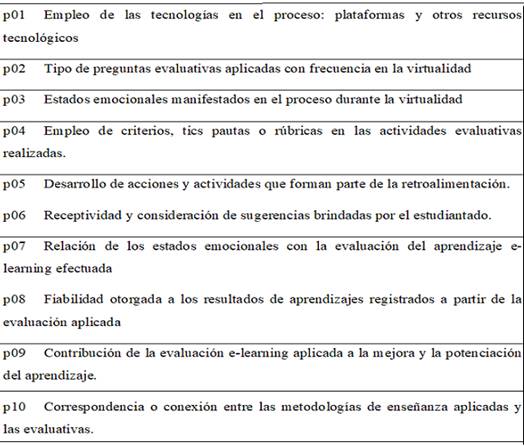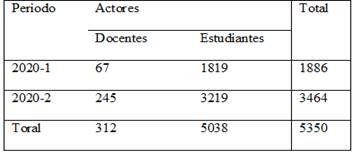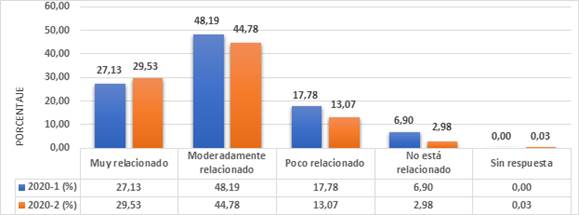Mi SciELO
Servicios Personalizados
Articulo
Indicadores
-
 Citado por SciELO
Citado por SciELO
Links relacionados
-
 Similares en
SciELO
Similares en
SciELO
Compartir
EduSol
versión On-line ISSN 1729-8091
EduSol vol.23 no.85 Guantánamo oct.-dic. 2023 Epub 05-Oct-2023
Original article
Virtual Educational Process: Characterization at Peninsula Santa Elena State University during COVID-19
1Universidad Estatal Península de Santa Elena, Ecuador.
The objective of this work was to characterize the virtual educational process developed at the Peninsula de Santa Elena State University, Ecuador, during COVID-19. A quantitative, descriptive and longitudinal study was conducted during two semesters (2020-1 and 2020-2). The sample consisted of 312 teachers and 5038 students. A validated instrument was applied and four dimensions were considered: technological, evaluative, psycho-affective and methodological congruence. Statistical analysis was performed using R and the Lilliefors and Wilcoxon rank tests. The results show an expanded use of technologies, an evaluation that, although it could be improved, showed acceptance and credibility, and a remarkable methodological congruence.
Key words: Virtual education; Educational technologies; Evaluation; Emotional states
Introduction
This research was developed during the COVID-19 pandemic, a stage in which educational processes were untimely affected on an international scale, which led to imperative curricular, methodological, technological and human adaptations of students and teachers, most of whom did not have experience in virtuality or sufficient skills in the use of technologies applied to education (García-Peñalvo, 2020).
Consequently, the use of technologies became a focus of attention at a global level, as shown by certain studies (Rashid & Yadav, 2020), which led to the development of massive training to help prepare teachers in their technological competencies, teaching and evaluation methodologies in virtuality, as well as in the attention to the emotional states of the actors in the process (ECLAC-UNESCO, 2020).
During this stage of the pandemic, studies were carried out in different countries that revealed some realities. In Mexico, for example, unfavorable results were observed, showing a low understanding of some learning contents and difficulties in the evaluation of teaching activities (Gervacio & Castillo, 2021).
There is concern about the effective use of technological resources in key processes for the improvement of learning, such as feedback and communication as ways to confer confidence to the relationship between teachers and students and positive emotional states, knowing that the latter are a reflection of the psycho-affective responses that are subject to or influenced by various educational factors (Al Lily et al., 2017), which makes us recognize the possibility of certain tensions or mismatches between the use of technologies and pedagogical-didactic competencies.
Considering this background and the contextual reality, at the beginning of the COVID-19 pandemic, a diagnostic study was conducted at the Peninsula de Santa Elena State University (UPSE), Ecuador, which reflected a poor experience in the virtual work of teachers and students, with a very limited use of educational technologies; numerous teacher and student trainings were then carried out, the technological infrastructure was improved and several curricular readjustments were made, in hours, in programs (syllabi) and with methodological suggestions.
The research presented here was initiated with the objective of characterizing the educational process developed, with the understanding that this would provide contextual scientific information and would allow the issuance of suggestions or instructional safeguards to help correct errors and make informed decisions for the required educational improvements.
Development
A quantitative, exploratory and descriptive study with a longitudinal scope was carried out in two consecutive semesters of 2020 (2020-1 and 2020-2). Theoretical analysis-synthesis, deductive and inductive methods were applied to analyze the bibliography and research results, making inferences, deductions and contrasting values.
In both semesters, a survey was applied to teachers and students of the institution, using the same instrument, previously validated by Ruiz et al. (2022), which included ten semi-closed questions related to core aspects of the teaching-learning process (Table 1).
The sampling applied was probabilistic and simple random; attributes such as gender, age, professional career orientation, and semesters to which the teachers and students belonged were not considered (Table 2).
For the organization and analysis of the results, the sample was statistically characterized and the questions of the questionnaire (p) were grouped into didactic components of the process, considered in this case as dimensions:
Technological dimension: contains question p01, related to teaching-learning means and resources.
Evaluative dimension: includes questions p02, p04, p05, p06, p08 and p09 on the evaluation of learning, which cover various methodological and procedural topics of the evaluation process.
Psycho-affective dimension that includes questions p03 and p07, related to the emotional states of participating students and teachers.
Methodological congruence dimension, which contains question p10, dealing with the logicity and connection between the methods and actions implemented.
The descriptive statistical analysis was performed in R (R Core team, 2020) and the Lilliefors test (Kolmogórov-Smirnov) of the nortest package (Gross & Ligges, 2015) was used to evaluate the normality of the observations made. The data collected from teachers and students did not fit a normal distribution (pvalue<0.000), so nonparametric statistical methods (Wilcoxon rank sum test with continuity correction) were used for comparison. Correlation analyses and their visualization were performed using the corrplot package (Wei & Simko, 2021).
The following are the most important results obtained
Statistical characterization of the sample (2020-1 and 2020-2)
Figure 1 shows the box-and-whisker plots of the scores obtained from the questions applied to teachers and students in the 2020-1 and 2020-2 periods, where medians close to the minimum values are assessed in all of them, as well as the dispersion offered by the interquartile range and the presence of outlier observations. The low values of the median scores are due to the presence of items whose responses are frequently zero.
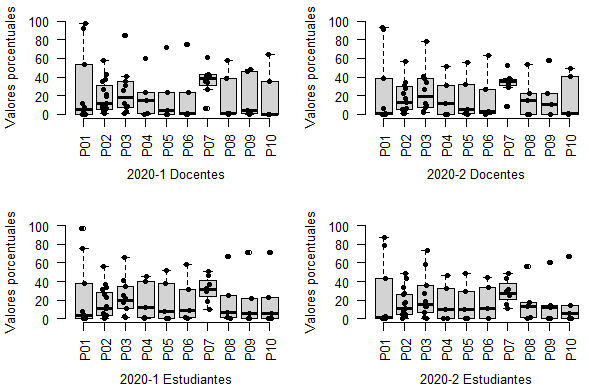 Source: Self elaboration
Source: Self elaborationFigure 1: Box-and-whisker plot of scores grouped by question for teachers and students surveyed in 2020-1 and 2020-2.
Technological dimension
The answers given by students and teacher to question p01 and the calculation of percentages revealed that the most used platforms were Moodle, Zoom and Microsoft Teams (Table 3); while the most used virtual objects and resources were forums, digital books, short videos and e-learning quizzes. Others such as mind maps, concept maps, chat and e-portfolios were rarely used.
Table 3 Use of technologies by teachers and students during the COVID-19 pandemic stage.
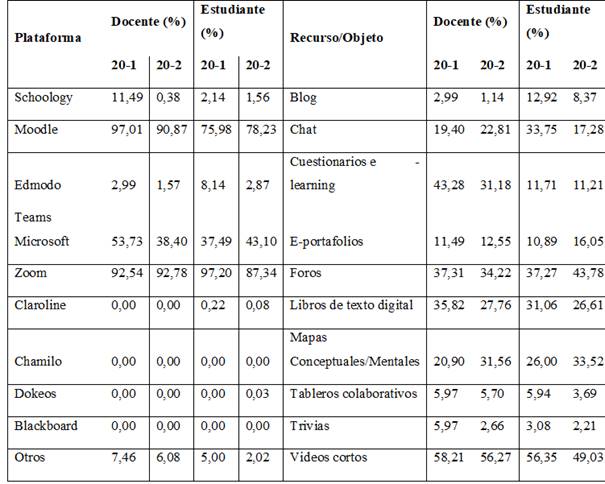
Source: Self elaboration
Evaluative dimension
The quantification of the answers to questions p02, p04, p05, p06, p08 and p09 of the questionnaire, which were obtained from the perceptions of teachers and students, made it possible to know some characteristics of the evaluative process of learning deployed during the periods 2020-1 and 2020-2 in the virtuality, in the pandemic stage.
The results obtained from question p02 on the types of evaluative questions applied and their frequency are shown in Figure 2.
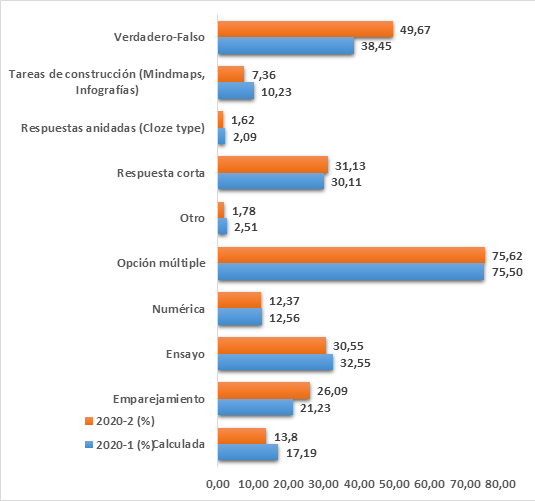 Source: Own elaboration
Source: Own elaborationFigure 2: Frequency of the types of evaluative questions used (perceptions of teachers + students).
The results obtained reflect a high coincidence between the perceptions of teachers and students and a great predominance of multiple choice, true/false and short questions, in that order. The calculation of the answers given by teachers and students to question p04 showed the use of evaluative criteria and the use of guidelines or rubrics, always and almost always during the learning evaluation process (Figure 3).
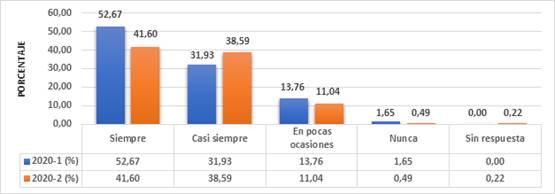 Source: Self elaboration
Source: Self elaborationFigure 3 Use of criteria, guidelines or rubrics for the qualification of the evaluative activities carried out (Teachers + Students).
The answers given by the actors in question p05 provided information on the extent to which the teachers provided feedback, clarified doubts, and offered guidance and suggestions to the students. The prevailing answers were always (S) and almost always (CS), as follows: in period 2020-1: 62.02 % (S) and 31.13 %; in period 2020-2: 42.67 % (S) and 40.27 %.
The calculation of the results of question p06 related to the attention and receptiveness shown by the teachers to the concerns and suggestions of the students is shown in Figure 4.
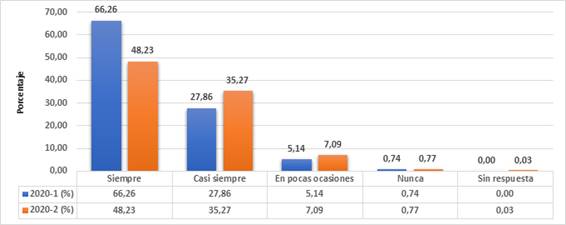 Source: Self elaboration
Source: Self elaborationFigure 4 Attention and receptiveness of teachers to students' concerns and suggestions in the evaluation process (Students + Teachers).
The answers given to question p08 showed how the actors in the process assessed the credibility or reliability of the learning results of the e-learning assessments applied (Figure 5).
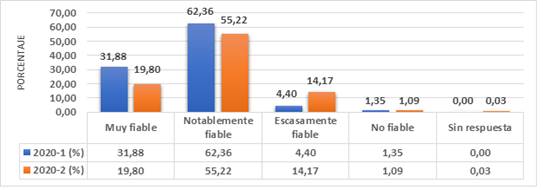 Source: Self elaboration
Source: Self elaborationFigure 5: Degree of reliability given to the learning results recorded from the e-learning evaluation (Teachers + Students).
The results of question p09 made it possible to know the assessment of the actors in the process on the contribution of the evaluation to the improvement and enhancement of their learning (Figure 6).
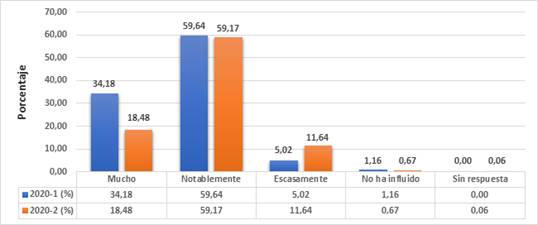 Source: Self elaboration
Source: Self elaborationFigure 6 Contribution of evaluation to the improvement and enhancement of learning (Teachers + Students).
Psycho-affective dimension
The answers to questions p03 and p07 reported the emotional states expressed by teachers and students. Due to the great coincidence in the answers obtained, the total values have been taken. The positive values are reflected in Figure 7, highlighting confidence and optimism.
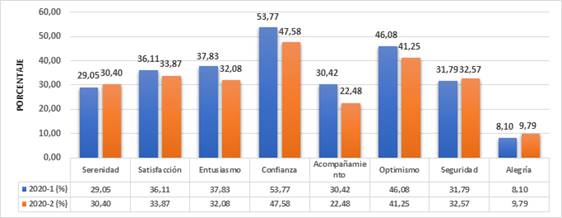 Source: Self elaboration
Source: Self elaborationFigure 7 Positive emotional states in teachers and students (Teachers + Students).
The values recorded for negative emotional states were lower than the positive ones, highlighting the following in decreasing order: Stress (2020-1: 71.01 % and 2020: 72.7 %); frustration (2020-1: 28.04 % and 2020: 37.23 %) and boredom (2020-1: 25.53 % and 2020: 26.64 %).
The measurement of the answers given to question p07 by the actors in the process revealed a high influence of the learning assessment that was practiced on the emotional states of the students (Figure 8).
Methodological congruence dimension
This dimension includes question p10, which allowed assessing the degree or extent to which the evaluation methodologies implemented: methods, techniques, instruments and evaluation procedures, articulate, connect or correspond with those applied for teaching. The evaluations made by the actors of the process (teachers and students) are reflected in Figure 9, which shows a predominance of high and moderate relationship.
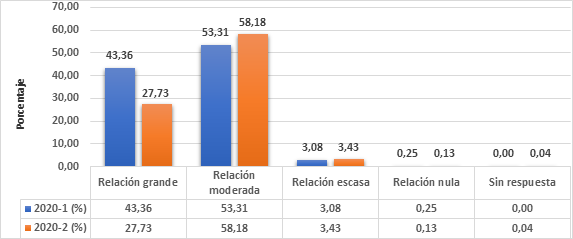 Source: Self elaboration
Source: Self elaborationFigure 9: Degree of correspondence or connection between the teaching methodologies applied and the learning evaluation methodologies (Teacher + Student).
The analysis of the results is presented below.
Statistical characterization of the sample (2020-1 and 2020-2)
From the statistical point of view, it can be considered according to the Wilcoxon rank sum test, that there are no significant differences (p-values ≥ 0.050) between the scores obtained through the instrument used for the different sampled groups of teachers (D) and students (E) in the periods 2020-1 and 2020-2, according to: D2020-1 vs. D2020-2 (0.811); E2020-1 vs. E2020-2 (0.859); D2020-1 vs. E2020-2 (0.962); and D2020-2 vs. E2020-1 (0.800).
The above allows us to consider a single population in this particular study, since there is a high degree of association, given by the high correlation coefficients reflected between the groups analyzed, as can be seen in the graph relating to the Spearman-Rho nonparametric correlation matrix (Figure 10). This could be reaffirmed in the high coincidence between the opinions of teachers and students, which gives reliability to the research.
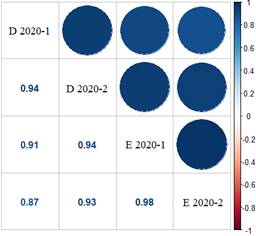 Source: Self elaboration
Source: Self elaborationFigure10: Correlation matrix between the different groups of scores for teachers (D) and students (E) in the two study periods 2020-1 and 2020-2.
Technological dimension
The use of three platforms and several technological resources denotes a remarkable amplitude in the use of technologies, which constitutes an indicator of flexibility and use of alternatives, which denotes a difference in relation to the usual practice in the face-to-face modality; this logically conditioned by the situation of the moment, which demanded the incorporation and massive assimilation of the techniques and resources necessary for the virtual modality.
The use of forums and short videos can be considered valuable from the interactive and audiovisual perspective of current didactics. Paradoxically, a scarce use of mental and conceptual maps, chats and e-portfolios, so suggested by the theory of meaningful learning, capable of contributing to self-regulation, to develop and evaluate competences and attitudes, was noted.
Evaluative dimension
The fact that the most frequently applied evaluative questions have been multiple choice, true and false and short answer questions, and that the least used are the nested (cloze), construction (concept and mental maps) and essay type questions, being precisely those that require productive and creative levels and significant learning, is worrying and at least leads to a critical reflection and a suggestion to teachers, since these most frequently used questions are usually very practical, but memoristic, reproductive and of low cognitive demand.
The aspects addressed in questions p04, p05 and p06, concerning the use of rubrics, feedback activities and the receptiveness shown by the teacher to the students' suggestions, are remarkable results as they contribute to the assertive nature of communication, to the reflection on the mistakes and the necessary adjustments in the study methods, which makes the evaluation a process aimed at improvement, to the co-construction of knowledge, procedures and attitudes in practice.
It is considered that these results justify and explain in part the answers given by the actors to question p08, in which they gave credibility to the evaluation results and recognized that the process contributed to the improvement of learning (p09), which is stimulating and at the same time confers confidence to the teaching management carried out.
Likewise, the high coincidence in the answers of teachers and students gives reliability to these results, considering that, at least, from their point of view, the evaluation and its results transmit security, correspond to reality and denote authenticity (p09).
Psycho-affective dimension
The analysis of the results of questions p03 and p07 cannot be made apart from the processes executed and the findings obtained from the previous questions. From this consideration, the positive emotional states that were recorded can be recognized as a merit of the process, determined by the joint work of teachers and students, and by the pedagogical and spiritual accompaniment provided to the students by their teachers in difficult and new situations experienced during the pandemic, which involved adaptation and demanded resilience to the challenges of the virtual modality, the technological limitations and the health problems that occurred.
The negative emotional states are usually generated by the hygienic-mental impact of the use of technologies, the methodological and pedagogical actions; the stimuli generated from the use of technologies and the teachers' way of proceeding, always have repercussions in one way or another and in some way, in the psyche and in the behavior of the students who are subject to such influences, which can sometimes be negative as well.
It is also possible to consider that the evaluative questions that prevailed (p02; figure 2), due to their traditional format and with strong memoristic nuances, also influenced the emotional states in a negative way, together with other possible factors, such as the excess of questions, the usually short time allotted and the lack of attractiveness that these questions often offer.
All of the above may explain why teachers and students agreed that the assessment practiced was "very and moderately related" to their negative emotional states such as stress, frustration and boredom.
Methodological consistency dimension
Methodological congruence in the teaching-learning processes involves the existing connection between the methods and the actions implemented, a topic that is, by the way, scarcely addressed.
From this perspective of analysis and taking into account that the majority of the actors themselves valued as high and moderate the connection and correspondence between the teaching methodologies and the evaluation methodologies applied by the teaching staff (p10), the methodological congruence can be evaluated as remarkable. It is logical to think that students and teachers, when answering, took stock of their expectations at the beginning of virtuality and their subsequent experiences, their achievements, progress and shortcomings.
Conclusions
The results obtained are generally acceptable and praiseworthy in a relative way, considering the other research previously consulted and the fact that 2020 was a school year of strong and abrupt changes that demanded adaptations in many aspects on the part of teachers and students, under the difficult conditions and effects generated by the COVID-19 pandemic.
The results indicate some shortcomings in the technological, evaluative and psycho-affective dimensions, which reveal questionable issues that suggest improvements: the scarce interactive and knowledge construction possibilities provided by the most used resources and techniques; predominant evaluative questions with short answers and low cognitive and procedural demand, which denote an anchorage in traditional practices and are related to negative emotional states, suggesting that teachers still need to break traditional schemes and be more innovative to enable deeper, interactive, collaborative and meaningful learning.
Referencias bibliográficas
Al Lily, A. E.; Foland, J. & Stoloff, D. (2017). Emotions in MOOCs: Theorizing the Role of Emotions in MOOCs. Distance Education, 38(1), 1-13. [ Links ]
CEPAL-UNESCO. (2020). Informe Covid-19 CEPAL-UNESCO: La educación en tiempos de la pandemia de COVID-19. https://www.cepal.org/es/%0Apublicaciones/45904-la-educaciontiempos-la-pandemia-covid-19 [ Links ]
García-Peñalvo, F. J. (2020). Evaluación online: la tormenta perfecta. Ensinar A Distância. [ Links ]
Gervacio, H., & Castillo, B. (2021). Impactos de la pandemia COVID-19 en el rendimiento escolar durante la transición a la virtualidad. Revista Pedagógica, 23, 1-29. [ Links ]
Gross, J. & Ligges, U. (2015). Nortest: Tests for Normality. https://cran.r-project.org/package=nortest [ Links ]
R Core team. (2020). R: A Language and Environment for Statistical . R Foundation for Statistical Computing. https://www.r-project.org/ [ Links ]
Rashid, S. & Yadav, S. S. (2020). Impact of Covid-19 pandemic on higher education and research. Indian Journal of Human Development, 14(2), 340-343. [ Links ]
Ruiz, Y.; Hernández, M.; Puya, A. & González, S. (2022). Educación Superior virtual: Validación de un instrumento en la Universidad Estatal Península de Santa Elena. Atenas, 1(57), 64-79. [ Links ]
Villarroel, V.; Pérez, C.; Rojas-Barahona, C. & García, R. (2021). Educación remota en contexto de pandemia: caracterización del proceso educativo en las universidades chilenas. Formación Universitaria, 14(6), 65-76. https://doi.org/http://dx.doi.org/10.4067/S0718-50062021000600065 [ Links ]
Wei, T. & Simko, V. (2021). R package «corrplot»: Visualization of a Correlation Matrix. https://github.com/taiyun/corrplot [ Links ]
Received: April 12, 2023; Revised: May 10, 2023; Accepted: July 18, 2023











 texto en
texto en 

